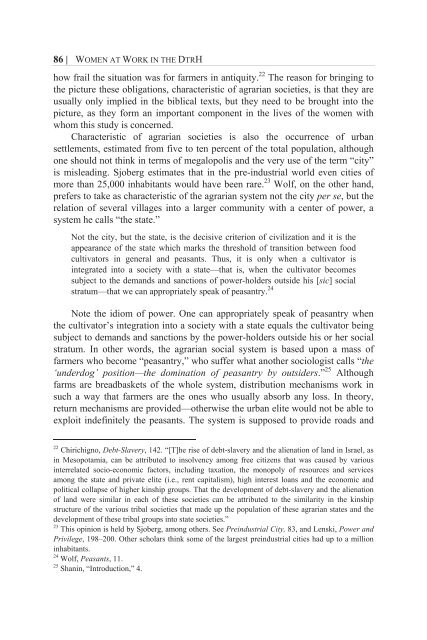Women at Work in the Deuteronomistic History - International Voices ...
Women at Work in the Deuteronomistic History - International Voices ...
Women at Work in the Deuteronomistic History - International Voices ...
Create successful ePaper yourself
Turn your PDF publications into a flip-book with our unique Google optimized e-Paper software.
86 | WOMEN AT WORK IN THE DTRH<br />
how frail <strong>the</strong> situ<strong>at</strong>ion was for farmers <strong>in</strong> antiquity. 22 The reason for br<strong>in</strong>g<strong>in</strong>g to<br />
<strong>the</strong> picture <strong>the</strong>se oblig<strong>at</strong>ions, characteristic of agrarian societies, is th<strong>at</strong> <strong>the</strong>y are<br />
usually only implied <strong>in</strong> <strong>the</strong> biblical texts, but <strong>the</strong>y need to be brought <strong>in</strong>to <strong>the</strong><br />
picture, as <strong>the</strong>y form an important component <strong>in</strong> <strong>the</strong> lives of <strong>the</strong> women with<br />
whom this study is concerned.<br />
Characteristic of agrarian societies is also <strong>the</strong> occurrence of urban<br />
settlements, estim<strong>at</strong>ed from five to ten percent of <strong>the</strong> total popul<strong>at</strong>ion, although<br />
one should not th<strong>in</strong>k <strong>in</strong> terms of megalopolis and <strong>the</strong> very use of <strong>the</strong> term “city”<br />
is mislead<strong>in</strong>g. Sjoberg estim<strong>at</strong>es th<strong>at</strong> <strong>in</strong> <strong>the</strong> pre-<strong>in</strong>dustrial world even cities of<br />
more than 25,000 <strong>in</strong>habitants would have been rare. 23 Wolf, on <strong>the</strong> o<strong>the</strong>r hand,<br />
prefers to take as characteristic of <strong>the</strong> agrarian system not <strong>the</strong> city per se, but <strong>the</strong><br />
rel<strong>at</strong>ion of several villages <strong>in</strong>to a larger community with a center of power, a<br />
system he calls “<strong>the</strong> st<strong>at</strong>e.”<br />
Not <strong>the</strong> city, but <strong>the</strong> st<strong>at</strong>e, is <strong>the</strong> decisive criterion of civiliz<strong>at</strong>ion and it is <strong>the</strong><br />
appearance of <strong>the</strong> st<strong>at</strong>e which marks <strong>the</strong> threshold of transition between food<br />
cultiv<strong>at</strong>ors <strong>in</strong> general and peasants. Thus, it is only when a cultiv<strong>at</strong>or is<br />
<strong>in</strong>tegr<strong>at</strong>ed <strong>in</strong>to a society with a st<strong>at</strong>e—th<strong>at</strong> is, when <strong>the</strong> cultiv<strong>at</strong>or becomes<br />
subject to <strong>the</strong> demands and sanctions of power-holders outside his [sic] social<br />
str<strong>at</strong>um—th<strong>at</strong> we can appropri<strong>at</strong>ely speak of peasantry. 24<br />
Note <strong>the</strong> idiom of power. One can appropri<strong>at</strong>ely speak of peasantry when<br />
<strong>the</strong> cultiv<strong>at</strong>or’s <strong>in</strong>tegr<strong>at</strong>ion <strong>in</strong>to a society with a st<strong>at</strong>e equals <strong>the</strong> cultiv<strong>at</strong>or be<strong>in</strong>g<br />
subject to demands and sanctions by <strong>the</strong> power-holders outside his or her social<br />
str<strong>at</strong>um. In o<strong>the</strong>r words, <strong>the</strong> agrarian social system is based upon a mass of<br />
farmers who become “peasantry,” who suffer wh<strong>at</strong> ano<strong>the</strong>r sociologist calls “<strong>the</strong><br />
‘underdog’ position—<strong>the</strong> dom<strong>in</strong><strong>at</strong>ion of peasantry by outsiders.” 25 Although<br />
farms are breadbaskets of <strong>the</strong> whole system, distribution mechanisms work <strong>in</strong><br />
such a way th<strong>at</strong> farmers are <strong>the</strong> ones who usually absorb any loss. In <strong>the</strong>ory,<br />
return mechanisms are provided—o<strong>the</strong>rwise <strong>the</strong> urban elite would not be able to<br />
exploit <strong>in</strong>def<strong>in</strong>itely <strong>the</strong> peasants. The system is supposed to provide roads and<br />
22<br />
Chirichigno, Debt-Slavery, 142. “[T]he rise of debt-slavery and <strong>the</strong> alien<strong>at</strong>ion of land <strong>in</strong> Israel, as<br />
<strong>in</strong> Mesopotamia, can be <strong>at</strong>tributed to <strong>in</strong>solvency among free citizens th<strong>at</strong> was caused by various<br />
<strong>in</strong>terrel<strong>at</strong>ed socio-economic factors, <strong>in</strong>clud<strong>in</strong>g tax<strong>at</strong>ion, <strong>the</strong> monopoly of resources and services<br />
among <strong>the</strong> st<strong>at</strong>e and priv<strong>at</strong>e elite (i.e., rent capitalism), high <strong>in</strong>terest loans and <strong>the</strong> economic and<br />
political collapse of higher k<strong>in</strong>ship groups. Th<strong>at</strong> <strong>the</strong> development of debt-slavery and <strong>the</strong> alien<strong>at</strong>ion<br />
of land were similar <strong>in</strong> each of <strong>the</strong>se societies can be <strong>at</strong>tributed to <strong>the</strong> similarity <strong>in</strong> <strong>the</strong> k<strong>in</strong>ship<br />
structure of <strong>the</strong> various tribal societies th<strong>at</strong> made up <strong>the</strong> popul<strong>at</strong>ion of <strong>the</strong>se agrarian st<strong>at</strong>es and <strong>the</strong><br />
development of <strong>the</strong>se tribal groups <strong>in</strong>to st<strong>at</strong>e societies.”<br />
23<br />
This op<strong>in</strong>ion is held by Sjoberg, among o<strong>the</strong>rs. See Pre<strong>in</strong>dustrial City, 83, and Lenski, Power and<br />
Privilege, 198–200. O<strong>the</strong>r scholars th<strong>in</strong>k some of <strong>the</strong> largest pre<strong>in</strong>dustrial cities had up to a million<br />
<strong>in</strong>habitants.<br />
24<br />
Wolf, Peasants, 11.<br />
25<br />
Shan<strong>in</strong>, “Introduction,” 4.




